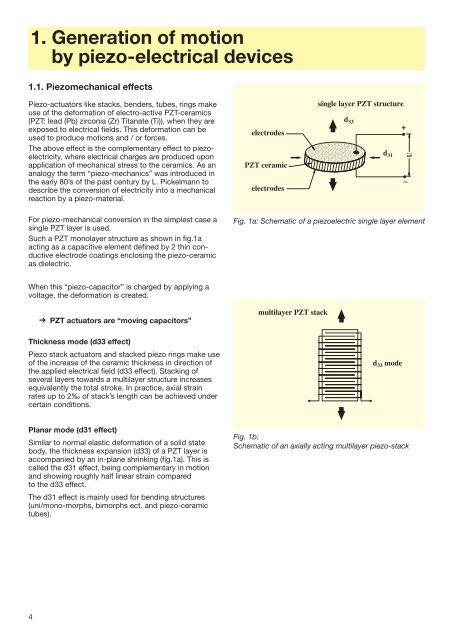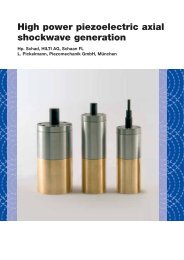231575 Piezo-Mechanics GB
231575 Piezo-Mechanics GB
231575 Piezo-Mechanics GB
Create successful ePaper yourself
Turn your PDF publications into a flip-book with our unique Google optimized e-Paper software.
1. Generation of motionby piezo-electrical devices1.1. <strong>Piezo</strong>mechanical effects<strong>Piezo</strong>-actuators like stacks, benders, tubes, rings makeuse of the deformation of electro-active PZT-ceramics(PZT: lead (Pb) zirconia (Zr) Titanate (Ti)), when they areexposed to electrical fields. This deformation can beused to produce motions and / or forces.The above effect is the complementary effect to piezoelectricity,where electrical charges are produced uponapplication of mechanical stress to the ceramics. As ananalogy the term “piezo-mechanics” was introduced inthe early 80’s of the past century by L. Pickelmann todescribe the conversion of electricity into a mechanicalreaction by a piezo-material.For piezo-mechanical conversion in the simplest case asingle PZT layer is used.Such a PZT monolayer structure as shown in fig.1aacting as a capacitive element defined by 2 thin conductiveelectrode coatings enclosing the piezo-ceramicas dielectric.Fig. 1a: Schematic of a piezoelectric single layer elementWhen this “piezo-capacitor” is charged by applying avoltage, the deformation is created. PZT actuators are “moving capacitors”Thickness mode (d33 effect)<strong>Piezo</strong> stack actuators and stacked piezo rings make useof the increase of the ceramic thickness in direction ofthe applied electrical field (d33 effect). Stacking ofseveral layers towards a multilayer structure increasesequivalently the total stroke. In practice, axial strainrates up to 2‰ of stack’s length can be achieved undercertain conditions.Planar mode (d31 effect)Similar to normal elastic deformation of a solid statebody, the thickness expansion (d33) of a PZT layer isaccompanied by an in-plane shrinking (fig.1a). This iscalled the d31 effect, being complementary in motionand showing roughly half linear strain comparedto the d33 effect.The d31 effect is mainly used for bending structures(uni/mono-morphs, bimorphs ect. and piezo-ceramictubes).Fig. 1b:Schematic of an axially acting multilayer piezo-stack4





